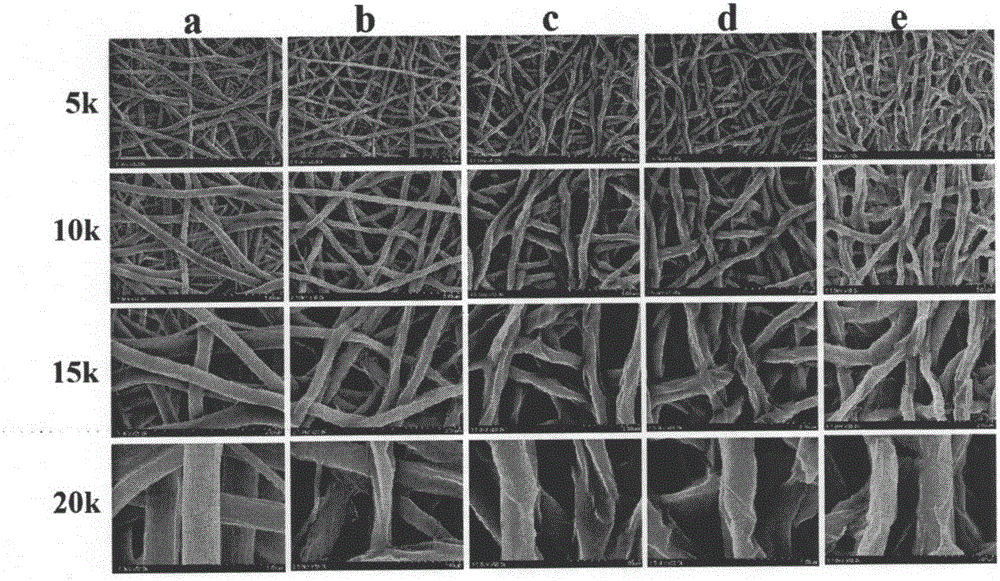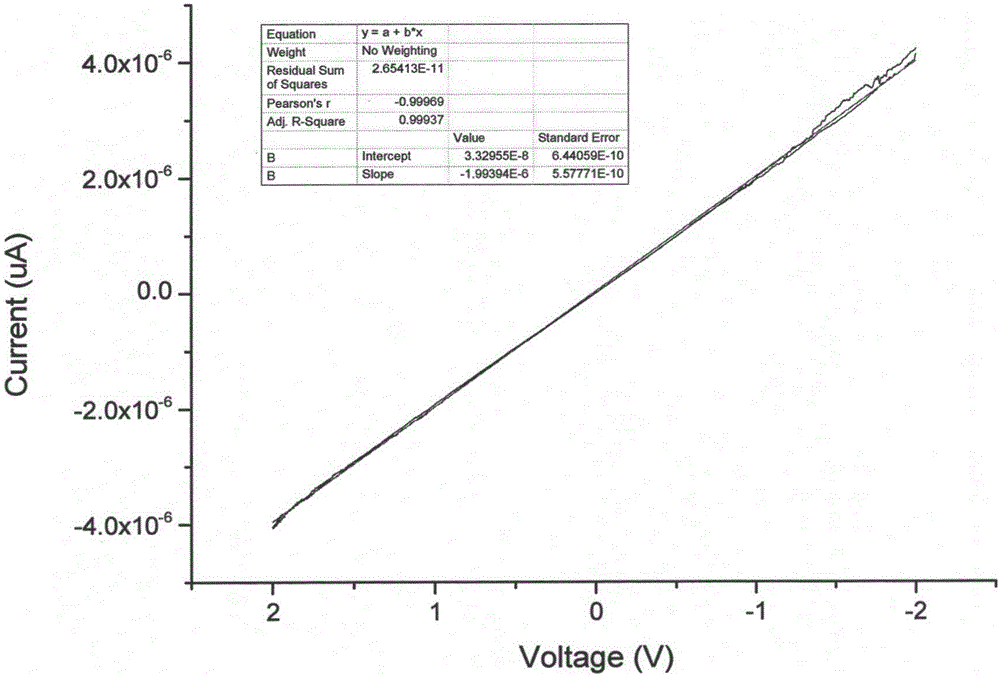Method for preparing conductive composite nanofiber nervous tissue engineering scaffold based on graphene
A technology of composite nanofibers and nerve tissue, applied in the direction of fiber type, fiber processing, animal fiber, etc., to achieve the effect of good biocompatibility, improved biological activity, and high porosity
- Summary
- Abstract
- Description
- Claims
- Application Information
AI Technical Summary
Problems solved by technology
Method used
Image
Examples
Embodiment 1
[0044] A preparation method based on graphene conductive composite nanofiber neural tissue engineering scaffold, the specific steps are:
[0045] 1. Place the tussah silk at 95~100℃ 2 CO 3 The degumming solution was degummed 3 times, each time for 30 minutes, and the bath ratio was 1:50. After degumming, the tussah silk fibers are obtained and dried at 60°C. Put the tussah silk fibroin fiber in a saturated LiSCN solution at a bath ratio of 1:10, dissolve it for 70 minutes at 50°C±2°C, put the obtained tussah silk fibroin protein solution into a dialysis bag with a molecular weight cut-off of 8-10KDa, and use Dialyzed with deionized water for 3 days, and freeze-dried to obtain tussah silk fibroin.
[0046] 2. Weigh 0.25g of tussah silk fibroin protein, 0.75g of polylactic acid-polycaprolactone, dissolve in 10ml of hexafluoroisopropanol, and magnetically stir at a certain speed until completely dissolved, and the obtained concentration is 10% (w / v ) spinning solution. Condu...
Embodiment 2
[0049] A preparation method based on graphene conductive composite nanofiber neural tissue engineering scaffold, the specific steps are:
[0050] 1. Place the tussah silk at 95~100℃ 2 CO 3 The degumming solution was degummed 3 times, each time for 30 minutes, and the bath ratio was 1:50. After degumming, the tussah silk fibers are obtained and dried at 60°C. Put the tussah silk fibroin fiber in a saturated LiSCN solution at a bath ratio of 1:10, dissolve it for 70 minutes at 50°C±2°C, put the obtained tussah silk fibroin protein solution into a dialysis bag with a molecular weight cut-off of 8-10KDa, and use Dialyzed with deionized water for 3 days, and freeze-dried to obtain tussah silk fibroin.
[0051] 2. Weigh 0.25g of tussah silk fibroin protein, 0.75g of polylactic acid-polycaprolactone, dissolve in 10ml of hexafluoroisopropanol, and magnetically stir at a certain speed until completely dissolved, and the obtained concentration is 10% (w / v ) spinning solution. Condu...
Embodiment 3
[0054] A preparation method based on graphene conductive composite nanofiber neural tissue engineering scaffold, the specific steps are:
[0055] 1. Put the tussah silk in the environment of 95~100℃, 2 CO 3 The degumming solution was degummed 3 times, each time for 30 minutes, and the bath ratio was 1:50. After degumming, the tussah silk fibers are obtained and dried at 60°C. Put the tussah silk fibroin fiber in a saturated LiSCN solution at a bath ratio of 1:10, dissolve it for 70 minutes at 50°C±2°C, put the obtained tussah silk fibroin protein solution into a dialysis bag with a molecular weight cut-off of 8-10KDa, and use Dialyzed with deionized water for 3 days, and freeze-dried to obtain tussah silk fibroin.
[0056] 2. Weigh 0.25g of tussah silk fibroin protein, 0.75g of polylactic acid-polycaprolactone, dissolve in 10ml of hexafluoroisopropanol, and magnetically stir at a certain speed until completely dissolved, and the obtained concentration is 10% (w / v ) spinnin...
PUM
| Property | Measurement | Unit |
|---|---|---|
| concentration | aaaaa | aaaaa |
Abstract
Description
Claims
Application Information
 Login to View More
Login to View More - R&D
- Intellectual Property
- Life Sciences
- Materials
- Tech Scout
- Unparalleled Data Quality
- Higher Quality Content
- 60% Fewer Hallucinations
Browse by: Latest US Patents, China's latest patents, Technical Efficacy Thesaurus, Application Domain, Technology Topic, Popular Technical Reports.
© 2025 PatSnap. All rights reserved.Legal|Privacy policy|Modern Slavery Act Transparency Statement|Sitemap|About US| Contact US: help@patsnap.com



